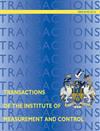2D lidar and ultra-wideband fusion location algorithm based on landmark assistance
IF 1.7
4区 计算机科学
Q3 AUTOMATION & CONTROL SYSTEMS
Transactions of the Institute of Measurement and Control
Pub Date : 2023-08-07
DOI:10.1177/01423312231189809
引用次数: 0
Abstract
In an indoor environment where global positioning system (GPS) signals are severely attenuated, ultra-wideband (UWB) and 2D lidar are widely used in the autonomous positioning of mobile platforms. However, the presence of nonline-of-sight (NLOS) environments can lead to large errors in UWB positioning, and 2D lidar will increase the cumulative error due to the loss of accuracy in sparsely textured scenes. In order to reduce the positioning error, a UWB and 2D lidar fusion positioning algorithm based on the assistance of a few landmarks is proposed in this paper. Considering the colored noise of lidar location data, a Kalman filter algorithm based on cumulative error analysis is proposed. First, the lidar error curve is fitted by the least-square method, and then the relationship between the noise covariance matrix and the lidar cumulative error function is established by introducing the scale factor, which is substituted into the Kalman prediction equation. Experimental results show that the proposed multi-sensor fusion localization algorithm is feasible, and compared with the single localization method, the proposed fusion algorithm can significantly improve the localization accuracy; matching landmarks can achieve a positioning accuracy of 0.15 m, which is about 24.4% lower than the root mean square error of traditional Kalman filter.基于地标辅助的二维激光雷达和超宽带融合定位算法
在全球定位系统(GPS)信号衰减严重的室内环境中,超宽带(UWB)和二维激光雷达被广泛用于移动平台的自主定位。然而,非线性视觉(NLOS)环境的存在会导致UWB定位中的大误差,并且2D激光雷达会由于在稀疏纹理场景中的精度损失而增加累积误差。为了降低定位误差,本文提出了一种基于几个地标辅助的超宽带和二维激光雷达融合定位算法。考虑到激光雷达定位数据的有色噪声,提出了一种基于累积误差分析的卡尔曼滤波算法。首先,采用最小二乘法拟合激光雷达误差曲线,然后通过引入比例因子建立噪声协方差矩阵与激光雷达累积误差函数之间的关系,并将其代入卡尔曼预测方程。实验结果表明,所提出的多传感器融合定位算法是可行的,与单一定位方法相比,该融合算法可以显著提高定位精度;匹配地标可以实现0.15的定位精度 m、 比传统卡尔曼滤波器的均方根误差低24.4%。
本文章由计算机程序翻译,如有差异,请以英文原文为准。
求助全文
约1分钟内获得全文
求助全文
来源期刊
CiteScore
4.10
自引率
16.70%
发文量
203
审稿时长
3.4 months
期刊介绍:
Transactions of the Institute of Measurement and Control is a fully peer-reviewed international journal. The journal covers all areas of applications in instrumentation and control. Its scope encompasses cutting-edge research and development, education and industrial applications.

 求助内容:
求助内容: 应助结果提醒方式:
应助结果提醒方式:


